

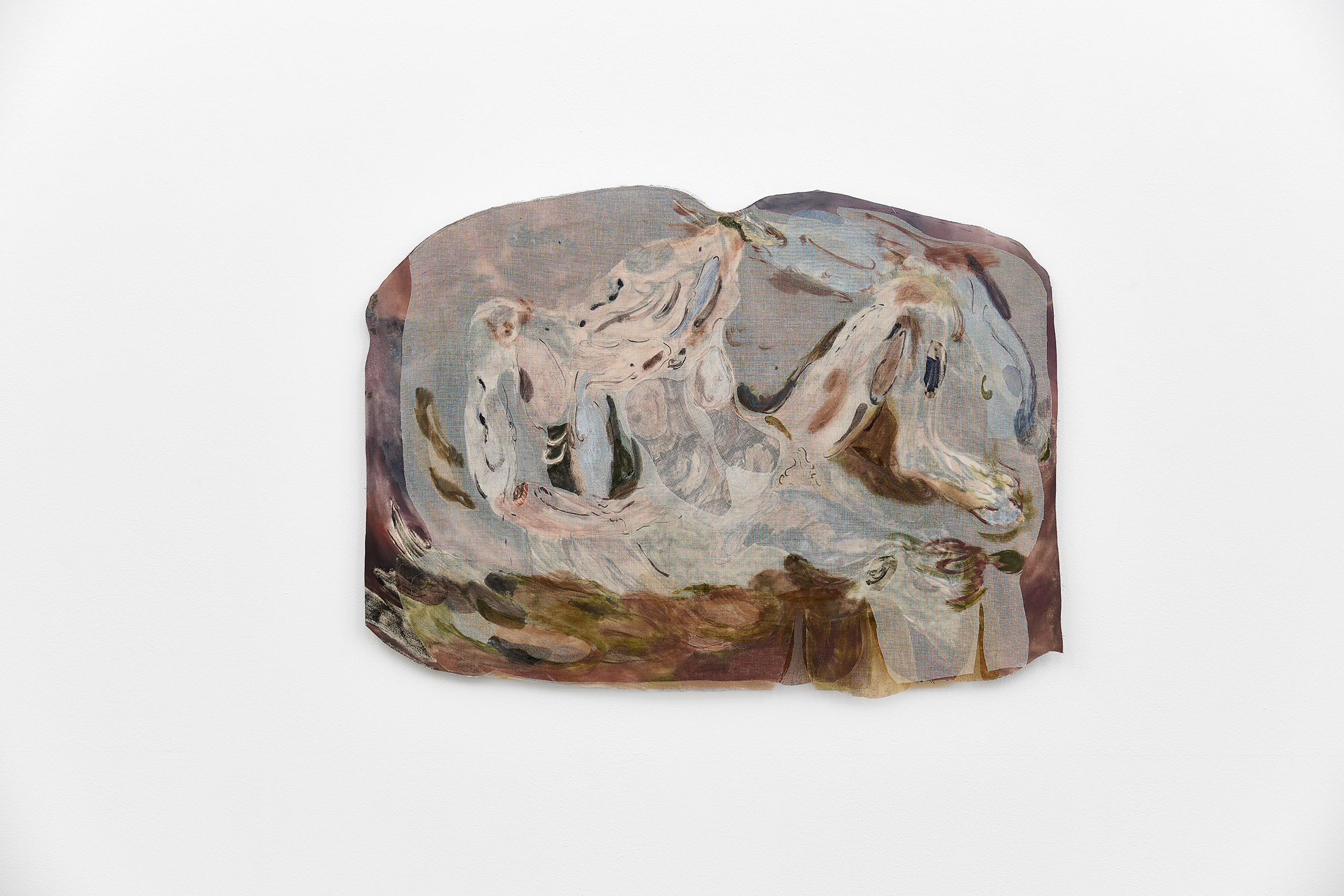
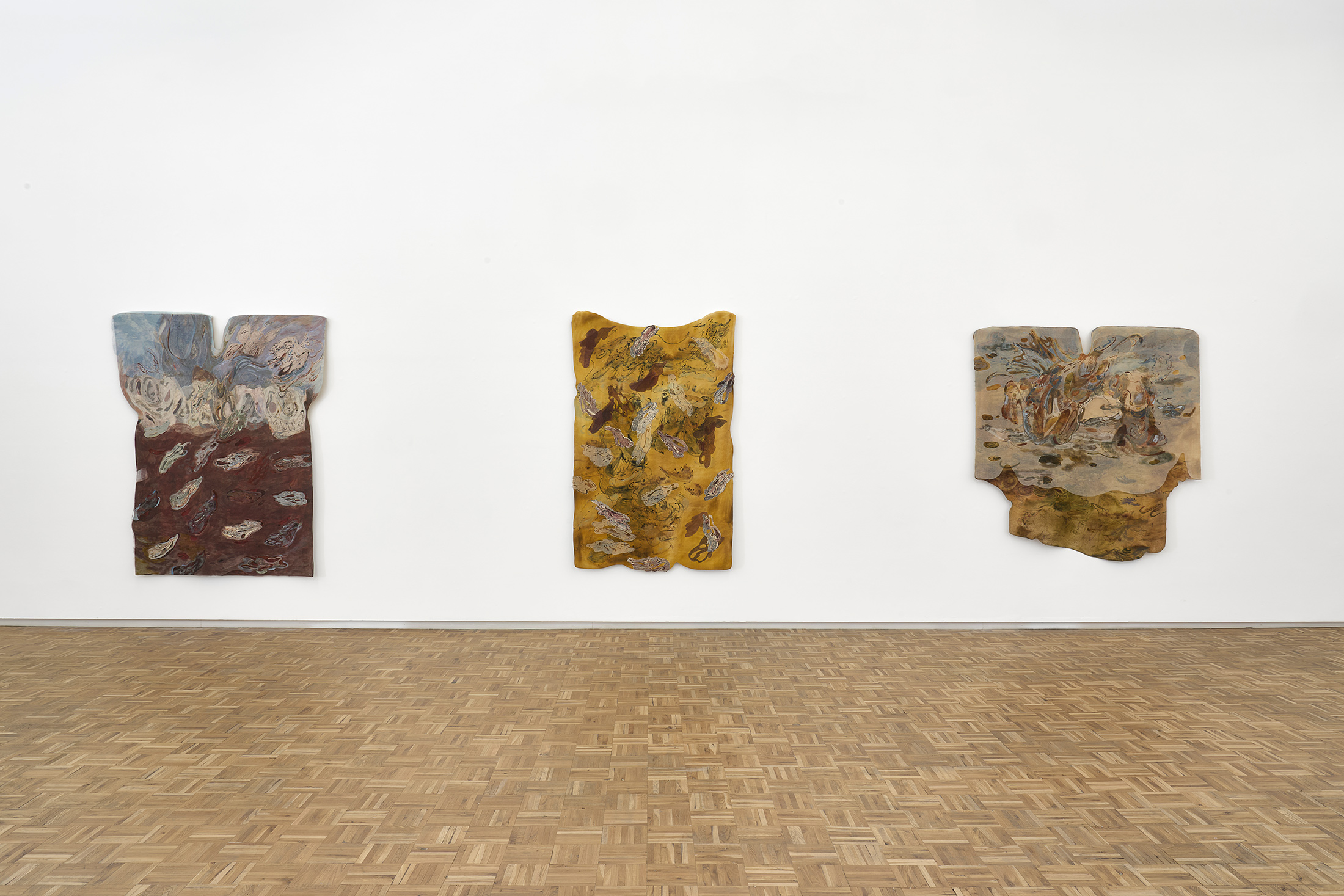
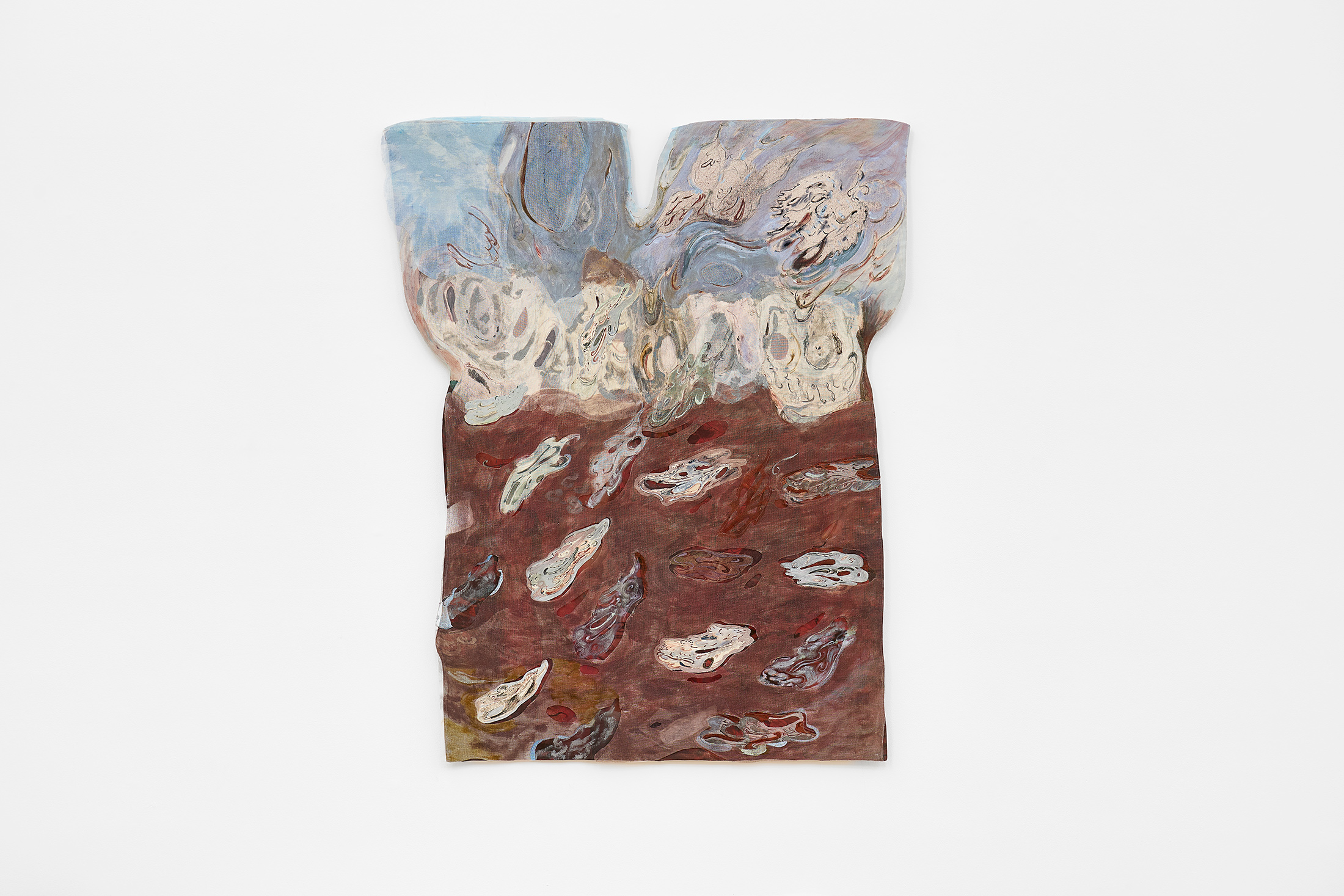
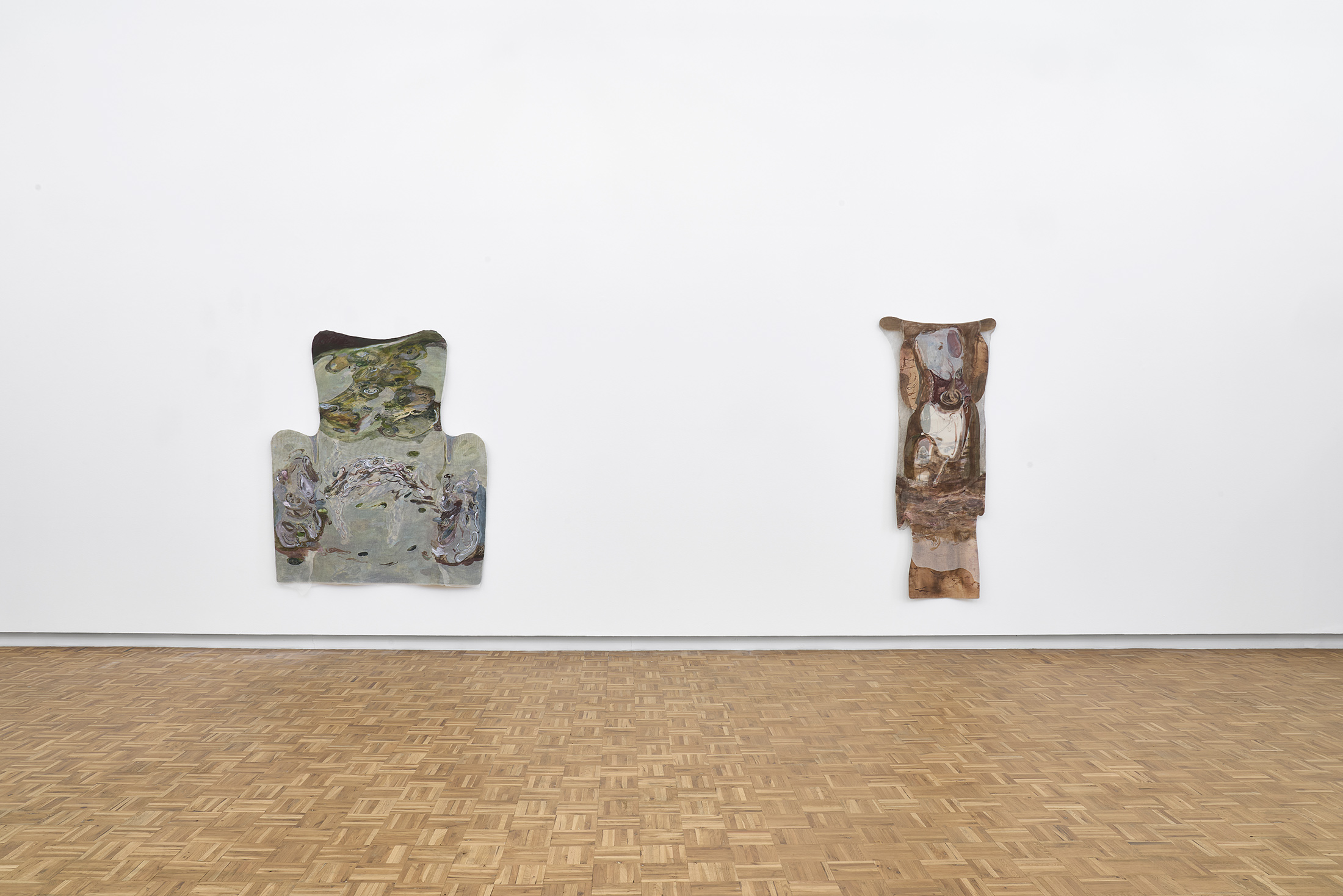
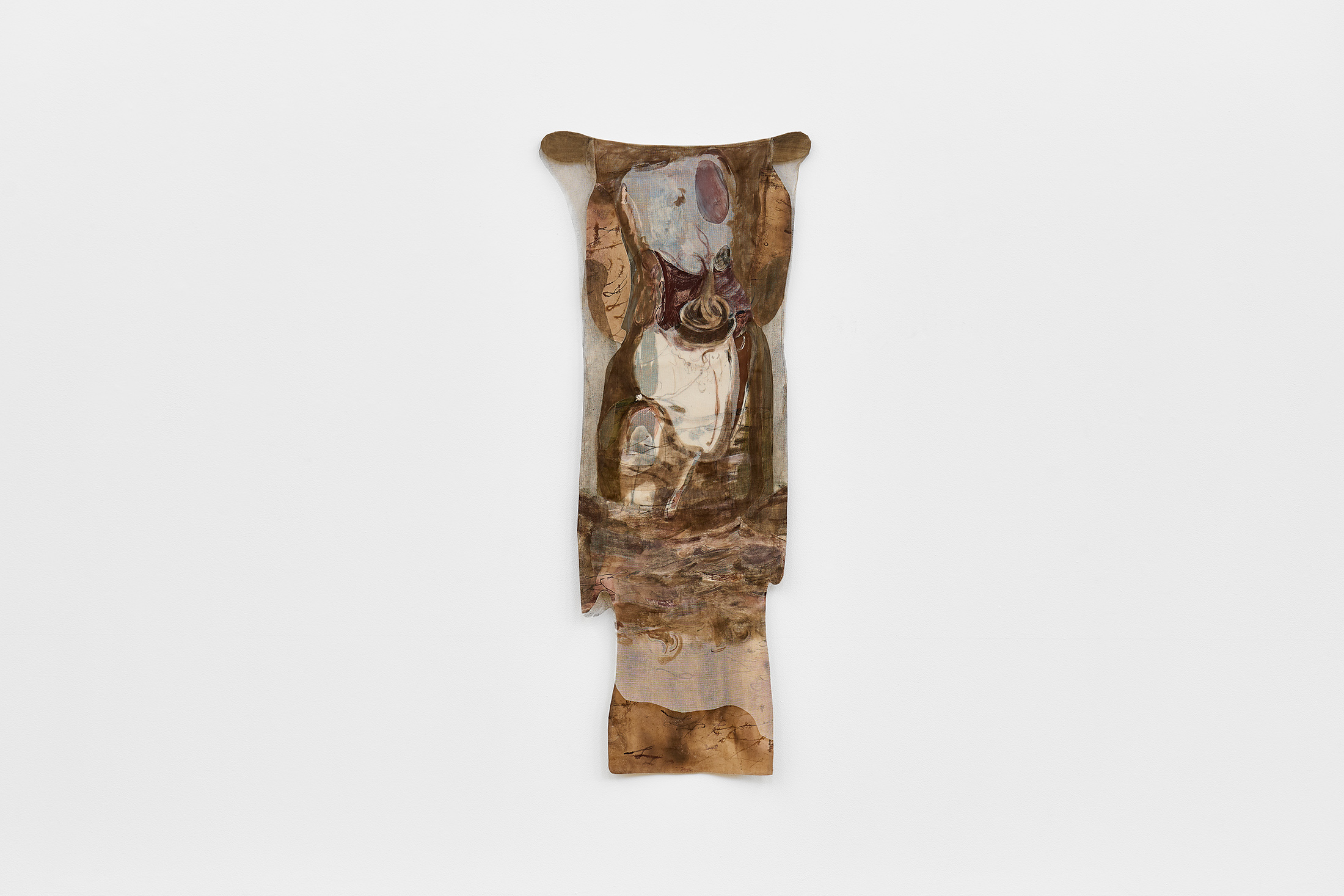
blank is pleased to present love charm dialects, a solo exhibition by Jeanne Gaigher, and her first with the gallery.
Words by Khanya Mashabela
In this new series of paintings, Jeanne Gaigher constructs a story of longing. Her protagonists are amoeba-like, enacting dramas of desire as they pull apart, stretch towards each other, and converge. Her narrative is intuitively expressed through amorphous lines and earthy colour palettes on rough, raw canvas, creating a world which feels primordial—her landscapes are simultaneously alien and familiar. There is no negative space, and often no clear foreground or background or delineation between subjects and their settings. These ambiguities of composition are furthered by her deft use of scrim, a material whose open weave offers both translucency and solidity, applied to surfaces in layers like leaves of paper which can be paged through.
The outcome is a deconstructed fresco: a story told through a choreographed grouping of sculptural paintings which demands close reading and an openness to imaginative association.
Gaigher metabolises a broad array of aesthetic approaches, cultural references, and lived experiences which she continuously departs from and returns to. In the absence of faces, her subjects communicate through their limbs, organs, cells. She is drawn to the enigmatic energy of Marcel Duchamp’s The Bride Stripped Bare by her Bachelors, Even (1915–23), a desire machine in which each visual element functions as part of a networked system. Its presence is felt in her wish to animate the inanimate, imbuing the disparate pieces inside of and around ourselves with their own autonomous thoughts and emotions.She is intrigued by the process of making new stories from old, such as in Anne Carson’s Autobiography of Red: A Novel in Verse (1998) about a winged, red monster named Geryon—taken from Greek mythology—engaged in a love triangle with two men which spans years and countries. This approach to reformulating source material is also present in another of Gaigher’s influences, Neon Genesis Evangelion (1997) a cult classic anime which intermixes themes from Shintoism, the Old Testament, and Psychoanalysis to tell the story of a war between an ancient race of destructive Angels and biomechanical soldiers, set in post-Apocalyptic Tokyo. The psychologically complex, transmorphic, human but supernatural beings described in both of these stories is where Gaigher’s mind goes when she refers to these paintings as ‘angels’ during our informal conversations in her studio.
The artist also responds to her more immediate context: the illustrations of an anatomy textbook which she keeps close at hand, Antjie Krog’s meditations on belonging in light of Afrikaans’ heavy history in A Change of Tongue (2003), the Cape’s indigenous flora and fauna, and the many dramas which take place on the streets of the city centre. More broadly, she is interested in expressions of desire and romance; the nature of being an organism in relation to other organisms; language and the acts of naming, taxonomising, narrating, and mythologising. Her touchstones are never explicit in the works and do not determine their reading, though they vibrate within them.
Here, painting is a mechanism of feeling through new ideas but also an end in itself.
Born in 1990, Jeanne Gaigher lives and works in Cape Town, South Africa. Recent solo exhibitions include Mind Middle at Paulina Caspari in Munich (2024), group psyche at RESERVOIR in Cape Town (2023), Hot Dipping at Emanuele Catellani Contemporary in Turin (2023) and Anatomy Lesson at Wschòd in Warsaw (2022). Selected group exhibitions include Homesick for Another World at Madragoa in Lisbon (2025), Cannibal Nature at Baró Galeria in Mallorca (2025), my galaxy at Paulina Caspari in Munich (2025), Memories We Have Forgotten at The Address Gallery in Brescia (2024), and The Sieve of Secrecy at Paulina Caspari and beacon in Munich (2023). Recognitions include the ARCOmadrid Young Talent Award 2025 and residencies such as tac.residency in Tuscany, Italy and the Villa Filanda Antonini residency under the Arper Feltrin Foundation.
Words by Khanya Mashabela
In this new series of paintings, Jeanne Gaigher constructs a story of longing. Her protagonists are amoeba-like, enacting dramas of desire as they pull apart, stretch towards each other, and converge. Her narrative is intuitively expressed through amorphous lines and earthy colour palettes on rough, raw canvas, creating a world which feels primordial—her landscapes are simultaneously alien and familiar. There is no negative space, and often no clear foreground or background or delineation between subjects and their settings. These ambiguities of composition are furthered by her deft use of scrim, a material whose open weave offers both translucency and solidity, applied to surfaces in layers like leaves of paper which can be paged through.
The outcome is a deconstructed fresco: a story told through a choreographed grouping of sculptural paintings which demands close reading and an openness to imaginative association.
Gaigher metabolises a broad array of aesthetic approaches, cultural references, and lived experiences which she continuously departs from and returns to. In the absence of faces, her subjects communicate through their limbs, organs, cells. She is drawn to the enigmatic energy of Marcel Duchamp’s The Bride Stripped Bare by her Bachelors, Even (1915–23), a desire machine in which each visual element functions as part of a networked system. Its presence is felt in her wish to animate the inanimate, imbuing the disparate pieces inside of and around ourselves with their own autonomous thoughts and emotions.She is intrigued by the process of making new stories from old, such as in Anne Carson’s Autobiography of Red: A Novel in Verse (1998) about a winged, red monster named Geryon—taken from Greek mythology—engaged in a love triangle with two men which spans years and countries. This approach to reformulating source material is also present in another of Gaigher’s influences, Neon Genesis Evangelion (1997) a cult classic anime which intermixes themes from Shintoism, the Old Testament, and Psychoanalysis to tell the story of a war between an ancient race of destructive Angels and biomechanical soldiers, set in post-Apocalyptic Tokyo. The psychologically complex, transmorphic, human but supernatural beings described in both of these stories is where Gaigher’s mind goes when she refers to these paintings as ‘angels’ during our informal conversations in her studio.
The artist also responds to her more immediate context: the illustrations of an anatomy textbook which she keeps close at hand, Antjie Krog’s meditations on belonging in light of Afrikaans’ heavy history in A Change of Tongue (2003), the Cape’s indigenous flora and fauna, and the many dramas which take place on the streets of the city centre. More broadly, she is interested in expressions of desire and romance; the nature of being an organism in relation to other organisms; language and the acts of naming, taxonomising, narrating, and mythologising. Her touchstones are never explicit in the works and do not determine their reading, though they vibrate within them.
Here, painting is a mechanism of feeling through new ideas but also an end in itself.
-
Born in 1990, Jeanne Gaigher lives and works in Cape Town, South Africa. Recent solo exhibitions include Mind Middle at Paulina Caspari in Munich (2024), group psyche at RESERVOIR in Cape Town (2023), Hot Dipping at Emanuele Catellani Contemporary in Turin (2023) and Anatomy Lesson at Wschòd in Warsaw (2022). Selected group exhibitions include Homesick for Another World at Madragoa in Lisbon (2025), Cannibal Nature at Baró Galeria in Mallorca (2025), my galaxy at Paulina Caspari in Munich (2025), Memories We Have Forgotten at The Address Gallery in Brescia (2024), and The Sieve of Secrecy at Paulina Caspari and beacon in Munich (2023). Recognitions include the ARCOmadrid Young Talent Award 2025 and residencies such as tac.residency in Tuscany, Italy and the Villa Filanda Antonini residency under the Arper Feltrin Foundation.